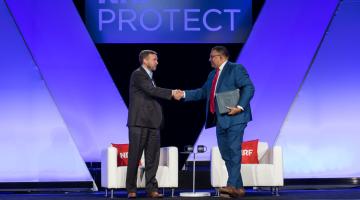
From left: Scott McBride of American Eagle Outfitters Inc., Jodie Kautt of Target, Diane Brown of Ulta Beauty and Deborah Weinswig of Coresight Research speak at NRF PROTECT 2023.
Whether it’s custom-built or off-the-shelf, plenty of technology solutions can protect against fraud and product loss as well as enhance the customer experience, according to a panel of retail security experts sharing their thoughts on next-gen technology trends at NRF PROTECT.
“I can see a vision of technology advancing and enabling more freedom, reducing friction, increasing productivity in stores and getting to a place where the data is so robust and actionable in the moment that we are able to proactively protect the business while having the customer have a free and open experience,” said Scott McBride, chief global asset protection officer and chief security officer at American Eagle Outfitters Inc.
Browse resources and read NRF's latest articles and press releases related to loss prevention.
Keeping the customer experience at the core of the security strategy has helped Target innovate and come up with new solutions, said Jodie Kautt, vice president, cybersecurity for the retailer. “We want to make sure we are putting our mitigation or prevention steps to disrupt this activity right in line with the guest experience flow that the fraudsters are taking advantage of,” she said.
In Target’s case, that often means building custom technology that can be utilized for both security and to enhance the customer experience. For example, thanks to its proprietary return technology, Target might offer an advance refund before it receives a returned item.
“We can do that because we put our custom risk engine right in line with our return flow and my team can identify things that look suspicious,” Kautt said.
For Diane Brown, vice president of IT risk management at Ulta Beauty, it’s about looking at existing technology and understanding the full scope of capabilities, not just the problem that technology is supposed to solve.
Last year, Ulta’s cyberthreat and intelligence and asset protection teams used data collected by a bot management tool to see that cyber criminals were looking at stores’ inventory of Dyson hair dryers. That information was relayed to the field LP team in that market to let them know of the potential threat.
“For us, it’s about knowing your environment, what you have and what the gaps are and then also partnering with the digital and the LP side to see where they’re seeing problems” so they can stay one step ahead, Brown said.
The focus is on “Being observant and looking outside of the norm, really talking to LP partners to understand what they’re looking for, and really looking at the data we have through that lens.”
Checkout the recap and learn more about NRF Protect 2023, covering insights and strategies on loss prevention, asset protection, digital fraud and cybersecurity.
In the future, generative AI will help retailers “find new patterns in a high ROI manner,” said panel moderator Deborah Weinswig, CEO of Coresight Research. “It’s a new way of looking at the data we have and getting in front of, and predicting, behaviors, so we can make better decisions.”
She also sees a future with a Web3 supply chain of connected data and decentralized ledgers that can provide more end-to-end visibility and thwart fraud and theft. While a public blockchain represents a greater level of traceability, trackability and transparency, not every retailer will be comfortable sharing that intelligence, Weinswig said, so the solution could be a partially private blockchain.
In any case, retailers need to start thinking today about where along the blockchain they feel comfortable sharing information and the goals of that intelligence sharing.
“As you think about getting started in a Web3 environment, we don’t want to cause friction, but we want to create a great environment for our customers, for our employees, not have to raise prices, ensure an item is in stock when fulfilling in stores,” Weinswig said. “One way to do this is through all of us collaborating and coming together.”
The future will also merge physical and digital shopping, including scanning high loss items into a digital basket while enjoying the tactile experience of browsing in-store and getting all items at the point-of-sale checkout, according to the panelists. “[Hybrid shopping] is where we’re all headed,” McBride said. “It just depends on how fast we can adopt.”


